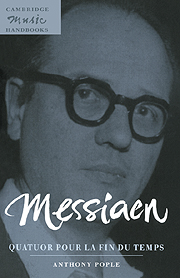Book contents
- Frontmatter
- Contents
- Acknowledgements
- Introduction
- 1 ‘Liturgie de cristal’
- 2 ‘Vocalise, pour l'Ange qui annonce la fin du Temps’
- 3 ‘Abîme des oiseaux’
- 4 ‘Intermède’
- 5 ‘Louange à l'Éternité de Jésus’
- 6 ‘Danse de la fureur, pour les sept trompettes’
- 7 ‘Fouillis d'arcs-en-ciel, pour l'Ange qui annonce la fin du temps’
- 8 ‘Louange à l'Immortalité de Jésus’
- 9 Contexts
- Appendix: Messiaen's modes à transpositions limitées
- Notes
- Select bibliography
- Index
2 - ‘Vocalise, pour l'Ange qui annonce la fin du Temps’
Published online by Cambridge University Press: 05 June 2012
- Frontmatter
- Contents
- Acknowledgements
- Introduction
- 1 ‘Liturgie de cristal’
- 2 ‘Vocalise, pour l'Ange qui annonce la fin du Temps’
- 3 ‘Abîme des oiseaux’
- 4 ‘Intermède’
- 5 ‘Louange à l'Éternité de Jésus’
- 6 ‘Danse de la fureur, pour les sept trompettes’
- 7 ‘Fouillis d'arcs-en-ciel, pour l'Ange qui annonce la fin du temps’
- 8 ‘Louange à l'Immortalité de Jésus’
- 9 Contexts
- Appendix: Messiaen's modes à transpositions limitées
- Notes
- Select bibliography
- Index
Summary
The first and third sections (very short) evoke the power of the mighty Angel, crowned with a rainbow and clothed by a cloud, who sets one foot upon the sea and one foot upon the earth. In the middle section – these are the impalpable harmonies of heaven. On the piano, gentle cascades of blue-orange chords, garlanding with their distant carillon the quasi-plainsong chanting of the violin and cello.
A vocalise – Rachmaninov's for soprano and piano (1912) is a famous example – is essentially a song without words. It is not an instrumental composition, however, as are Mendelssohn's Lieder ohne Worte, but a wordless song for a singer. So, as in the case of the contact between nature and Heaven effected in ‘Liturgie de cristal’, Messiaen's use of the term vocalise here seeks to perform an act of identification. The song in this second movement ‘is’ a song for the Angel, though what we hear are the instruments of the Quatuor.
Form
As Messiaen's prefatory remarks explain, the movement falls into three main sections. This large-scale articulation, which immediately distinguishes the ‘Vocalise …’ from the manner of the first movement, is made crystal clear by the tempo markings in the score.
The first part begins in the modéré tempo of the previous movement, but is here additionally marked robuste in reflection of the musical character; after two bars comes a virtual doubling of the notated tempo (presque vif, joyeuxy = c. 104), and these two tempi continue to alternate, ending with the presque vif at ii/C.1–2 and the modéré at C:3–7.
- Type
- Chapter
- Information
- Messiaen: Quatuor pour la fin du temps , pp. 28 - 39Publisher: Cambridge University PressPrint publication year: 1998



